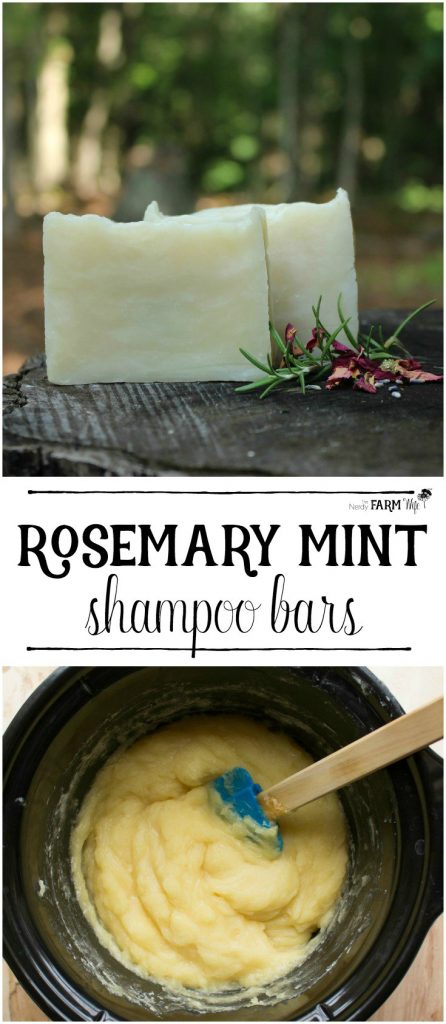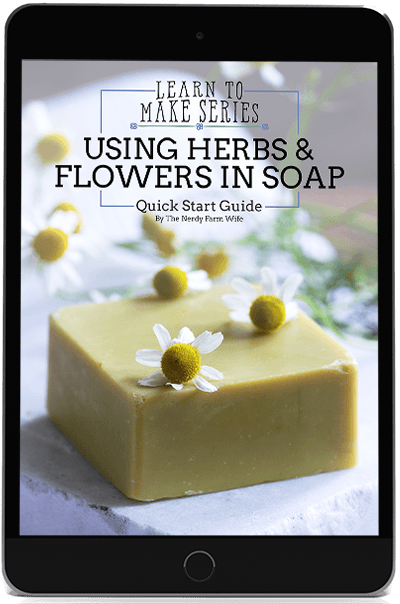Rosemary Mint Shampoo Bars (Crock Pot or Cold Process Method)

Shampoo bars are similar to regular bars of soap in many ways, only they usually contain a lot more castor oil, for a great lathering experience, along with herbs and oils that are especially nice for your hair.
Below, I’m sharing a recipe for Rosemary Mint Shampoo Bars, but you could use another essential oil (such as lavender) if you’d like.
If you’re interested in learning more about shampoo bars and soapmaking in general, be sure to check out my Handmade Natural Soaps eBook Collection.
Some links on this site are affiliate links. I only recommend products I’ve personally purchased & like. :)
Ingredients for Rosemary Mint Shampoo Bars
All measurements are given by weight. You must use an accurate scale to make soap.
- 10 oz (283 g) olive oil
- 8 oz (227 g) coconut oil
- 4 oz (113 g) castor oil
- 4 oz (113 g) sunflower or sweet almond oil
- 2 oz (57 g) jojoba oil
- 3.82 oz (108 g) lye (sodium hydroxide)
- 10 oz (283 g) distilled water or light rosemary tea for hot process soap, or 9 ounces (255 g) water or tea for cold process directions
- 15 g peppermint essential oil (abt 4 tsp)
- 5 g rosemary essential oil (abt 1.5 tsp)
If making hot process, you’ll also need a 4 quart crock pot (slow cooker).
Notes & Tips
If you’d like to use a light rosemary tea instead of distilled water, place about 1 tablespoon fresh or dried rosemary into a heat proof canning jar and pour 11 ounces of simmering hot water over the herbs. Steep just until the water starts turning color then strain and chill. (Herbal teas must be chilled or completely cool before using in soap to avoid overheating.) Rosemary tea can affect the final color, especially if the tea is strong dark brown, so keep it light while infusing!
If you’re pregnant, have hypertension or epilepsy, rosemary essential oil should be avoided or used with care under the supervision of a health care professional. You can omit the rosemary essential oil completely, or replace it with lavender essential oil.
Directions are given to make either hot process (Crock Pot) or cold process method. If making hot process, use the full 10 oz of water. If making cold process, reduce the water amount to around 9 oz (255 g).
Superfat is 5%. For a 6% superfat, use 3.78 oz (107 g) of lye (sodium hydroxide) instead.
This recipe is sized to fit a Crafter’s Choice Regular Silicone Loaf Mold.
Look for lye at your local hardware store or Amazon. I like ComStar or Essential Depot brands.

Directions to Make Rosemary Mint Shampoo Bars
* If you’ve never made soap before, read over Soap Making 101 first and study up on the process before proceeding.
Step 1 – Wearing gloves and goggles, weigh the distilled water into a heatproof container. Weigh the lye next, then carefully sprinkle and stir it into the water. Don’t breathe in the temporary, but strong, fumes. Set the solution aside in a safe place to cool, while you measure out the oils.
If making hot process soap (in your Crock Pot), the lye solution only needs to cool for around 15 to 20 minutes. If making cold process soap, let it cool for 30 to 40 minutes first, so the temperature drops to around 100 to 110°F (38 to 43°C).
Step 2 – Weigh and melt the coconut oil, then combine them with the other oils. If needed, warm the oils further to bring the temperature up to somewhere around 90 to 100°F (32 to 38° C).
Step 3 – Pour the lye solution into the oils. Using a combination of hand stirring and a stick (or immersion) blender, mix until trace is reached. This step can take anywhere from two to eight minutes.
Step 4, Cold Process Option – At this point, if making cold process soap, stir in the essential oils then pour directly into a mold, cover and insulate with a towel or blanket. Let the soap stay in the mold for 1 to 2 days, then unmold and slice into bars. Let the shampoo bars cure for at least 4 weeks before using.
Step 4, Hot Process Option – If making hot process soap, you’ll need to further cook the soap in your crockpot or slow cooker. Place the raw soap batter in a crockpot or slow cooker turned to low. Keep covered and cook for 1 hour, stirring every 15 minutes. After the cook time is done, let cool for a few minutes, stir in the essential oils, then spoon into a mold. Keep in mold for 24 hours before cutting. Hot process soap can be used right away, but still benefits from 2 to 3 weeks of cure time.
Tips for Using Shampoo Bars
Wet your hair, then lather up the shampoo bar with your hands. Rub the lather through your hair and scalp, similar to if you were using shampoo. Rinse well.
For best results, follow with a vinegar rinse. (See Lavender Vinegar, Rose Petal Vinegar or Violet Vinegar posts for infused vinegar ideas.)
Certain hair types or those with hard water may find that shampoo bars don’t work as well. It’s hard to know for sure though until you try a recipe out for yourself.
If you find that you don’t like a shampoo bar recipe for your hair, it will still make a terrific soap for your hands and body!




I enjoy reading your articles. Your directions are very clear and easy to follow. I would have confidence using them.
That’s great to hear Cheryl! Thanks! :)
Dear Jan: I recently found your site and am enjoying reading about all the wisdom you have gained. You must be one busy lady! Anxious to try the shampoo bars, especially, but some of the other soaps as well. Thanks for sharing it all with us!
God bless!
Barb
Hi Barb, I’m glad you enjoy the site! I hope you like the shampoo bars and soap recipes! :)
Thank you for such an informational site and tips. Could we use cold process to make this shampoo bar?
I am recently doing a bigger batch about 2 kilos in a big mould. A formula for olive oil soap that I made perfectly fine before, I just use the same formula increase proportionately, but the mixture went through gel phase and remains sticky. I wonder what went wrong. Could a bigger mould affect my results?
Hi By! Yes, you sure can make this shampoo bar recipe cold process. At trace, add your essential oils, as desired, and then pour into molds. Just skip the cook part and let the bars cure for four to six weeks. Re the other recipe that you resized larger: did you rerun it through a lye calculator? It’s possible too that a larger batch might need some longer time in the mold if it’s thicker/deeper. You could also try decreasing the water next time, to help it firm up faster.
is it possible to substitute the lye for castile soap?
Hi Blake! While castile soap is made using a form of lye, it can’t be substituted for lye directly. (You can kind of think of it in the same way that you can’t use a potato chip to replace the salt in a cake recipe.) In order to make soap (even castile soap or commercial soaps, unless they’re detergent based) you have to have oils + a strong caustic substance. In the olden days, they made their own caustic substance out of wood ashes. The problem was that it wasn’t consistent and nobody really knew how much to use to ensure a gentle soap. Now, we have a standardized product (sodium hydroxide for bars and potassium hydroxide for liquid soaps) that makes sure every batch turns out exactly balanced and gentle.
During the soap making process, molecules of oil match up with molecules of lye. At the end of the chemical reaction, you don’t have oils or lye anymore – you have a brand new substance – soap and glycerin! It’s pretty amazing! Another way to think of it is how sodium and chloride (two things you wouldn’t want to ingest separately!) come together to form a new substance – salt. So, that was my long-winded way of saying that you can’t make soap without lye or another strong caustic substance. :) The lye is essential to the recipe.
Hi Jan
Thnx for all the wonderful recipes. I was looking at this today and was wondering if i can use the same recipe and do it the cold process way as I do not want to spend on a crock pot for soaping.
Thnx
Pam
Hi Pamela! Yes, you sure can! You won’t need quite as much water for cold process, so you could reduce the water by around 1 ounce and it will set up a lot faster in the mold for you. :)